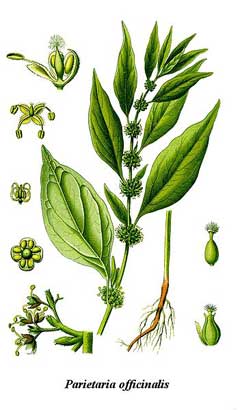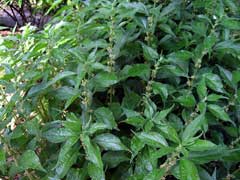 |
|
http://commons.wikimedia.org/wiki/File:Cleaned-Illustration_Parietaria_officinalis.jpg |
 |
| http://cs.wikipedia.org/wiki/Wikipedista:Dezidor |
Translate this page:
Summary
Physical Characteristics

 Parietaria officinalis is a PERENNIAL growing to 0.6 m (2ft) by 0.6 m (2ft in).
Parietaria officinalis is a PERENNIAL growing to 0.6 m (2ft) by 0.6 m (2ft in).
It is not frost tender. It is in flower from June to October. The species is dioecious (individual flowers are either male or female, but only one sex is to be found on any one plant so both male and female plants must be grown if seed is required). and is pollinated by Wind. The plant is not self-fertile.
Suitable for: light (sandy), medium (loamy) and heavy (clay) soils and prefers well-drained soil. Suitable pH: mildly acid, neutral and basic (mildly alkaline) soils. It can grow in semi-shade (light woodland) or no shade. It prefers dry or moist soil.
UK Hardiness Map
US Hardiness Map
Synonyms
Plant Habitats
North Wall. In. East Wall. In. West Wall. In.
Edible Uses
Edible Parts: Leaves Shoots
Edible Uses:
Young plant - raw or cooked[2, 105]. The young shoots can be added to mixed salads[7].
References More on Edible Uses
Medicinal Uses
Plants For A Future can not take any responsibility for any adverse effects from the use of plants. Always seek advice from a professional before using a plant medicinally.
Cholagogue Demulcent Diuretic Laxative Refrigerant Urinary Vulnerary
Pellitory of the wall has been valued for over 2,000 years for its diuretic action, as a soother of chronic coughs and as a balm for wounds and burns[254]. In European herbal medicine it is regarded as having a restorative action on the kidneys, supporting and strengthening their function[254]. The whole herb, gathered when in flower, is cholagogue, slightly demulcent, diuretic, laxative, refrigerant and vulnerary[4, 7, 61, 165, 238]. It is an efficacious remedy for kidney and bladder stones and other complaints of the urinary system such as cystitis and nephritis[4, 238, 254]. It should not be prescribed to people with hay fever or other allergic conditions[238]. The leaves can be usefully employed externally as a poultice on wounds etc[4]. They have a soothing effect on simple burns and scalds[7]. The plant is harvested when flowering and can be used fresh or dried[238].
References More on Medicinal Uses
The Bookshop: Edible Plant Books
Our Latest books on Perennial Plants For Food Forests and Permaculture Gardens in paperback or digital formats.

Edible Tropical Plants
Food Forest Plants for Hotter Conditions: 250+ Plants For Tropical Food Forests & Permaculture Gardens.
More

Edible Temperate Plants
Plants for Your Food Forest: 500 Plants for Temperate Food Forests & Permaculture Gardens.
More

More Books
PFAF have eight books available in paperback and digital formats. Browse the shop for more information.
Shop Now
Other Uses
Cleanser
The whole plant is used for cleaning windows and copper containers[7].
Special Uses
References More on Other Uses
Cultivation details
Prefers a well-drained to dry alkaline soil in full sun or semi-shade[238]. The plant grows well on drystone walls[17]. The pollen of this plant is one of the earliest and most active of the hay fever allergens[7]. Dioecious. Male and female plants must be grown if seed is required.
References Carbon Farming Information and Carbon Sequestration Information
Temperature Converter
Type a value in the Celsius field to convert the value to Fahrenheit:
Fahrenheit:
The PFAF Bookshop
Plants For A Future have a number of books available in paperback and digital form. Book titles include Edible Plants, Edible Perennials, Edible Trees,Edible Shrubs, Woodland Gardening, and Temperate Food Forest Plants. Our new book is Food Forest Plants For Hotter Conditions (Tropical and Sub-Tropical).
Shop Now
Plant Propagation
Seed - sow spring or autumn in a cold frame. Prick out the seedling when they are large enough to handle and plant them out in the summer. If you have sufficient seed then it can be sown in situ in autumn or spring. Division in spring. Very easy, larger divisions can be planted out direct into their permanent positions. We have found that it is better to pot up the smaller divisions and grow them on in light shade in a cold frame until they are well established before planting them out in late spring or early summer.
Other Names
If available other names are mentioned here
Native Range
TEMPERATE ASIA: Iran, Turkey, Armenia, Azerbaijan, Georgia, Russian Federation (Dagestan) EUROPE: Austria, Czech Republic, Germany, Hungary, Slovakia, Moldova, Ukraine (incl. Krym), Albania, Bulgaria, Greece, Croatia, Italy (incl. Sicily), North Macedonia, Montenegro, Romania, Serbia, Slovenia, France (incl. Corsica)
Weed Potential
Right plant wrong place. We are currently updating this section.
Please note that a plant may be invasive in one area but may not in your area so it's worth checking.
Conservation Status
IUCN Red List of Threatened Plants Status :

Growth: S = slow M = medium F = fast. Soil: L = light (sandy) M = medium H = heavy (clay). pH: A = acid N = neutral B = basic (alkaline). Shade: F = full shade S = semi-shade N = no shade. Moisture: D = dry M = Moist We = wet Wa = water.
Now available:
Food Forest Plants for Mediterranean Conditions
350+ Perennial Plants For Mediterranean and Drier Food Forests and Permaculture Gardens.
[Paperback and eBook]
This is the third in Plants For A Future's series of plant guides for food forests tailored to
specific climate zones. Following volumes on temperate and tropical ecosystems, this book focuses
on species suited to Mediterranean conditions—regions with hot, dry summers and cool, wet winters,
often facing the added challenge of climate change.
Read More
Expert comment
Author
L.
Botanical References
200
Links / References
For a list of references used on this page please go here
Readers comment